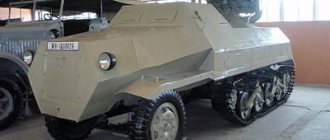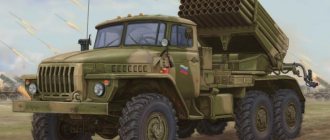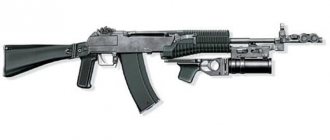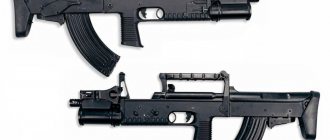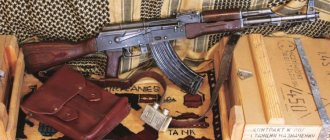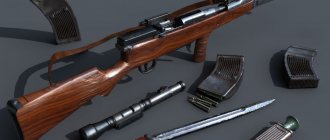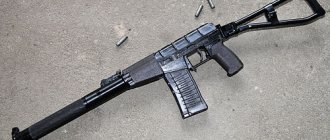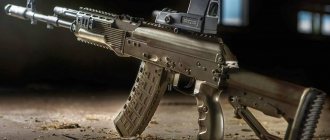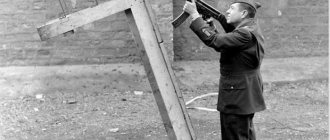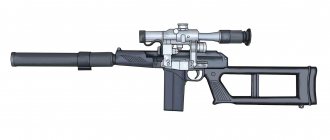Three-barreled killer: how Korobov’s “machine guns of the future” remained out of work
Miracle Yudo of the Tula gunsmith
Engineer German Korobov is called the unrecognized king of small arms - despite the fact that most of his futuristic developments remained experimental projects. The Tula gunsmith developed machine guns with a monstrous rate of fire and accuracy of fire.
"408th" engineer Korobov
There has always been an unspoken confrontation among gunsmith designers in the Soviet Union: whoever makes a machine gun suitable for service the fastest wins. However, despite the adoption in 1947 of the newest and most promising Kalashnikov assault rifle, there was one more copy, which in terms of its shooting and operational characteristics was at least no worse. The machine gun, designed to participate in a competition for advanced weapons, just like the AK, was designed for the 7.62x39 cartridge, but it had such unusual shapes and appearance that the use of this machine for testing purposes was postponed “due to mistrust.”
The unusual product, designed by the Soviet engineer German Korobov, amazed the imagination: the traditional design and layout of the weapon were actually sent to a landfill and instead, technologies and design were used that instantly gave the machine an advantage over almost any type of small arms. The assault rifle with the working title TKB-048 was head and shoulders above all competitors presented in the competition: it had less weight, dimensions, and was made in smoother forms and was superior to the Kalashnikov assault rifle in terms of rate and accuracy of fire.
German Korobov himself, who developed and assembled the miracle of small arms technology, is an outstanding person. He was one of the first Soviet engineers to study the effect of the rate of fire on accuracy and, through a series of experiments, was able to prove that if in the hands of an ordinary shooter, for example, while running or on the move, there would be a machine gun capable of shooting at a speed twice as high as the rate of fire from a conventional machine gun - then the accuracy of the battle in a particular case will double. It was on the high rate of fire and increasing the density and accuracy of fire that Korobov decided to build all his subsequent machine guns, simultaneously focusing on a general simplification of the weapon’s operation scheme. German Korobov was able to achieve amazing success not only using an unusual layout. The Soviet engineer’s very approach to weapon design was almost a whole generation ahead of all existing technical solutions.
Three-barrel Korobov
Despite the futuristic design, ergonomics that resembled an imperial blaster rather than a Soviet machine gun, Korobov was on his way to success. Realizing the success of his scheme, German Aleksandrovich developed an even more formidable, unimaginable-looking three-barreled machine gun. The product, later called the “three-barreled salvo machine gun,” was created in 1962 at the Tula Design Bureau. The basis of the machine gun, the firepower of which would be enough to mow down an entire platoon, was based on the same proven “bullpup” scheme, which Korobov used not because, but contrary to all traditional weapon schemes, considering it the most promising. With the concept of the machine gun, the designer defined an ultra-fast rate of fire in bursts, at which the recoil impulse does not have time to affect the weapon and affect the accuracy of fire in automatic mode. By combining three barrels in one machine gun, German Korobov achieved the virtually impossible: the rate of fire of automatic weapons increased to a monstrous 1800 rounds per minute. Another engineering solution was to borrow some components of the Kalashnikov assault rifle - a simple technique that contributed to serious unification with the huge number of standard weapons of the Soviet army.
Military historian and small arms operation engineer Igor Korneev explained in an interview with the Zvezda TV channel:
“The 59th has already shown everything it is capable of in testing. The Soviet army had never seen such a machine gun. The essence of the machine gun is that there are two firing modes - salvo and burst, and in both modes the accuracy of fire at distances of up to 150 meters was such that Kalashnikov would not have been able to achieve in principle. Projecting this machine gun into an intense battle, we can safely say that a reconnaissance company armed with such machine guns could completely destroy an entire military town, for example. The 7.62x39 cartridge is serious, and with a rate of fire of almost two thousand rounds, it’s generally possible to put out the lights. However, there were some holes in this scheme. Preparation is the main problem of the machine. It was almost impossible to “switch” from an AK or AKM to the Korobov version of an assault rifle right away, because it took a long time to get used to the weapon. An ordinary soldier would not be able to cope with this task,” the expert said.
Despite the fact that the Korobov assault rifle was recommended for trial use in the army, the Soviet leadership never made a positive decision on this project. A unique machine gun, capable of turning a Soviet special forces soldier or paratrooper into a real machine for destroying the enemy, remained as an experienced miracle of a Tula engineer.
Pioneer of balanced automation
If everything is more or less clear with the product number 408, then the competition to create a new machine gun at the turn of the 70s is generally a topic for a separate story. As you know, the competition for the creation of a promising modernized assault rifle ended with the adoption of the Kalashnikov AK-74 assault rifle in 1974. However, the “seven-four” was adopted with great difficulty, and in fact a new product was at the lower limit of what was developed for the technical specifications. In general, the story of the AK-74 could have ended in nothing if German Korobov had been able to provide the vehicle in time, redesigned taking into account the comments. German Korobov began his work on the TKB-072 product as usual - after a whole series of experiments with 5.45x39mm ammunition. By working on prototypes, the Soviet engineer was able to find out that the accuracy of fire can be directly influenced by using a two-rate design in the new machine gun. It is this concept that forms the basis for the creation of the TKB-072 assault rifle with balanced automatics, which had every chance of becoming the best assault rifle in the hands of a Soviet soldier.
However, following the spirit of the times, the Korobov assault rifle does not pass operational tests. It is difficult to say reliably for what reasons the Soviet leadership of the project decided in favor of the AK-74, but Korobov’s project was clearly underestimated.
“It’s difficult to understand why Korobov’s sample was not accepted. This, if you remember, is the same story as with the Stechkin assault rifle - they saw a non-standard approach and got scared. I know for sure that there were the most complaints about the Korobov assault rifle, but no serious flaws were found. At that time, it was customary to cut off everything unusual and not attach any importance, although, for example, the design of the 072 machine gun chambered for 5.45 was virtually ideal. This scheme is now probably the prototype for the machines from Kovrov. Surely you know about the development of the AEK project - this is precisely the legacy and continuity of Korobov’s schemes, for the most part. In a word, if they adopted it, they would act very wisely. Its reliability would be no worse than that of the same Kalash, but the accuracy and rate of fire is just a song, even after the AK-12 this is unlikely to be achieved,” says Roman Vyaznik, an expert in the field of small arms and the head of the tactical shooting center.
Project "Abakan"
TKB-0111 is one of the few Korobov assault rifles made according to the so-called “classical” design. This machine gun was provided for participation in testing of the Abakan project, already familiar to fans of small automatic weapons. The very idea of choice in the Abakan project, according to the assurances of most weapons experts in Russia, was very ambiguous.
An expert in the field of small arms, a former sniper in the special forces, Oleg Shirokin, in an interview with the Zvezda TV channel, told several interesting facts related to the Korobov assault rifle and its history in the Abakan project:
“I won’t tell this story in its entirety, but in short, of the samples provided, only the Stechkin and Nikonov samples made it to the finals. For various reasons, these two examples chambered for 5.45 turned out to be the most successful. The question of how and why exactly they were considered successful is still unanswered. There is no official conclusion on this topic. The “Korobovsky” machine gun, in turn, just think about it, was “recommended” for voluntary production without a written production agreement on the part of the military. What exactly the leaders of the Abakan competition wanted to say is unclear. One thing is clear - that if all three variants of assault rifles were allowed for trial use in the army: Nikonov, Stechkin and Korobov, I personally think that the choice would have to be between the Stechkin with its reliability and accuracy, and the Korobov assault rifle with its rate of fire and accuracy. Nikon’s option, in my deep conviction, would have been left behind.”
Dmitry Yurov, TRC "Zvezda"
Test results
According to other qualifying criteria, the weapon in question also performed well. The ease of maintenance and ease of disassembly were excellent and not inferior to competitors. However, Bulkin was unable to solve the problem of the survivability and reliability of his “brainchild”. This ultimately negated all the efforts of the designer. The commission selected a sample of the Kalashnikov assault rifle to undergo field testing.
The Bulkin AB-46 assault rifle did not meet the GAU requirements and did not pass the final tests. Despite the fact that the AK-47 was adopted for service in 1949, the modification in question made a significant contribution to the development of this machine gun, since many of the mechanisms and parts of its competitors are almost identical.
In conclusion
During the competition, one of the commission members saw a significant discrepancy between the AK-46 and the declared project. However, his mouth was quickly shut down, since the final word belonged to the Kolomna testers, who pretended not to notice such drastic changes. Despite this, the AK-46 still lost to the 1946 Bulkin assault rifle and the Dementiev gun. The saving straw for the project was the fact that none of the presented models reached the required tactical and technical parameters.
Bulkin's assault rifle was the only one of the three that demonstrated accuracy at the level of GAU requirements. It was also superior to the AK in terms of ergonomics and had a frame folding stock, which Kalashnikov only introduced several decades later. The decision to introduce a pair of flag switches may have been rightfully controversial, but improving the existing mechanism would not have been particularly difficult. By and large, the designer was let down by poor-quality manufacturing of the components, as in the story with the Simonov rifle. Despite the current situation, the Bulkin assault rifle left a bright mark in the history of domestic weapons, since it had a rather interesting design and good prospects.
TKB-415 AUTOMATIC MACHINE, NOT PASSED IN THE COMPETITION
Design
The designer created a sample based on the principle of automatic gas exhaust, the unit of which is located above the barrel. To lock the stem canal, a rotary principle was used. The device for removing gases does not have a regulator, and the locking block consists of a stem and a rod ending in a gas piston. The bolt stem is equipped with a hole for the combat rotating cylinder with a pair of stops.
When moving the bolt stem of a Bulkin assault rifle, the combat cylinder is first rotated, then two stops are removed from the coupling with the breech supports. The subsequent movement of the stem is carried out with the fighting larva picked up. The direction of movement is set by the folds of the stamped shutter box. They have an extremely reduced contact surface, which ensures low susceptibility to contamination. Charges are supplied from a magazine with capacity for 30 rounds. The cartridges are staggered and have a double-row feed. The holder is made of thin steel alloy by stamping and welding.
Operating principle
The Bulkin AB-44 assault rifle, like its modernized version, is equipped with a trigger mechanism with interception of the trigger. This unit is a simple device that does not have a device that separates the hook and sear. The opening-type bolt stem cocks the hammer; when the trigger is lowered, it intercepts the sear ledge. The trigger mechanism ensures firing in single shots or bursts.
The flag-type fire mode regulator is located on the right side of the barrel, above the trigger. Some variations of the weapon in question had a barrel shortened by 100 millimeters. The safety lever is mounted on the left side of the machine, which makes it easy to change its modes with the thumb of your right hand. The sight is controlled by an adjustable front sight with ring protection and a sector rear sight.
Technical plan characteristics
Two samples of the AB-46 assault rifle were presented at the competitive tests:
- Option with a wooden stock for equipping general military units.
- A model with a folding stock, intended for use in special units and airborne groups.
Below are the main technical parameters of the machine in question:
- Total weight – 4.5 kg.
- Length – 0.94 m.
- Trunk – 0.51 m.
- The target range of the shot is 0.8 km.
- The starting speed of the charge is 750 meters per second.
- The rate of fire is 600 rounds per minute.
- The number of ammunition in the clip is 30 rounds.
